As
you view this page, always keep something in mind. Fire
service terms vary greatly from place to place. No
doubt you will read terms here you have never seen.
There are more than five different names for a stand-by
fire rescue crew. What one department calls a "Halligan" another
may call a "Hooligan Tool" and another may
refer to the same piece of equipment as a "Pro
Tool". Young or new firefighters also tend to
believe that their department's way or terminology
is the only way, or that their department invented
the term. (Of course sometimes they do.) Resident's
of community's will also believe that their fire department
represents all fire departments and has the same terminology,
practices or traditions as those across the country.
Nothing could be further from the truth. People
email us all the time about an emblem on a badge, they
have seen or they ask, "Why do all fire departments...?" If
you can't find examples on the internet, it might mean
that your question is about a local tradition or term.
The best advice given might be, "Ask
the fire department that uses the term."
NOTE: Even though we have traveled to many fire departments and communicated with hundreds of fire service people, all over the world, we will undoubtedly omit terms and traditions. If you have a question or know of something we have left out, please help me make this site more accurate by letting us know.
Can't
find what you are looking for here?
Be sure to try our Q & A / Trivia page or the new EMS
Glossary page.
Contents A-B-C-D-F-G-H-I-J-K-L-M-N-O-P-Q-R-S-T-U-V-W-X-Y-Z
≈A≈
A-Wagon- This
is another all purpose, regional, term. Often this
is applied to vehicles designed to fight grass or brush
fires. Although some departments may use this term
to describe hazardous materials apparatus. In these
cases they can pump foam or other specialized agents
for the control of particular types of fires. The name
comes from the fact that these vehicles, in the past,
had an entirely separate “Auxiliary” motor
that ran the pump. This allowed these vehicles to pump
and roll at the same time. Modern fire apparatus pumps
get their power from the vehicle’s engine. The
transfer case forces you to choose between rolling
down the road or supplying the pump with power. The
word "auxiliary" simply means "a separate, support
piece of equipment." This might be an application of
the term for some departments.
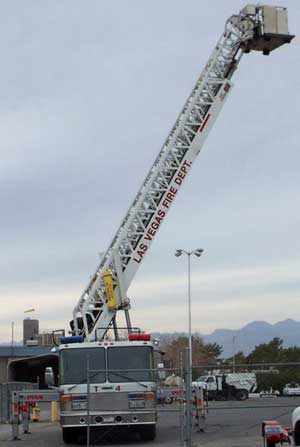
Aerial
Truck - Also known as a ladder truck, aerial
ladder, or just plain truck. A hydraulically
powered ladder or articulating platform, mounted
on a vehicle that also carries several different
length extension ladders, and possibly extrication
gear, ventilation equipment, and lighting Some
trucks can reach as high as 200 feet! See Truck.
Apparatus-
Any vehicle that serves a specific function other than
just transportation of people. Engines, Trucks, and
MICU’s are examples of apparatus. A chief’s
vehicle is generally NOT considered apparatus although
some departments may refer to it as such.
Air
Pack - A Self Contained Breathing Apparatus.
See (SCBA)
Jump
to: A-B-C-D-F-G-H-I-J-K-L-M-N-O-P-Q-R-S-T-U-V-W-X-Y-Z
≈B≈
Backdraft -
Term applied to the explosion caused by the sudden
inward rush of oxygen when all of the super-heated
gases, (heated above the ignition temperature) in a
room or structure, ignite at the same time. If the
gasses are pressurized, in a relatively closed room,
an explosion could be the result. While the likelihood
of such an occurrence is low, a backdraft is often
fatal to anyone caught in it.
Bangor
Ladder - This
is a 50 foot or larger ladder that has "tormenter
poles" to assist in the raising and to stabilize
the sides. It is also called a "pole ladder".
It takes several firefighters to raise this ladder.
These are sometimes used when a structure is inaccessible
by aerial apparatus. They are very resource intensive
to set. It might require eight firefighters to raise
one of these ladders.
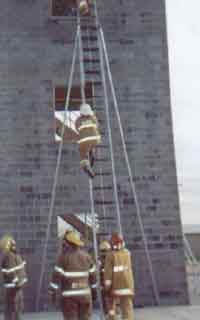
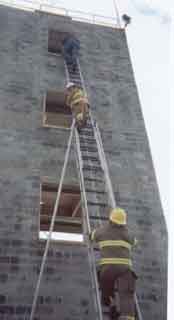
Photos - Michael Smith
Note: Every so often someone asks if the name "Bangor
Ladder" has anything to do with the town of Bangor, Maine.
The best answer might be, "Well Bangor would have you think so."
If
you go to Bangor,
Maine's website you can find your way to their
fire museum. They list, among the items you can see
there, "An Original Bangor Ladder".
Update: I have found the information below about Bangor ladders. It comes from a forum and references a source I can't find. It appears to be good information, but I can't verify it. I do accept it as factual due to the account found in a historical document.
From: http://www.geocaching.com
"Major James M. Davis, a joiner from Bangor, Maine, is credited with designing the Bangor Ladder after he returned from the Civil War and was elected captain of the Champion Hook & Ladder Company. Davis designed the Bangor Ladder in an effort to solve the major downfall of most lengthy ladders at the time -- their tendency to fail under stress because the solid, wooden beams on early extension ladders would sag and often break at the joint of the bed and fly. Single ladders that were long enough to reach the uppermost buildings in cities were out of favor because of their great weight. Long, heavy tormentor poles (also called prongs) were used in the early days to help raise the long ladders, but these poles were often carried separately from the ladder. Davis is credited with being the first person to develop an extension ladder with permanently attached tormentor poles that would fit flush to the ladder while stored on the truck. When needed at a fire the poles would easily swing out to assist in lifting the ladder as well as stabilizing the ladder once in place."
"Davis' new ladder was an immediate hit with firefighters in the Greater Bangor Area. However, it was General Joseph Smith, a Civil War Congressional Medal of Honor winner, that saw the value of Davis' ladder for a nation that was increasingly building upwards with taller and taller buildings. The General purchased Davis' interest in the ladder and set up the Bangor Extension Ladder Company. By 1890 hundreds of the Bangor Ladders were in service in most major cities. New York City purchased 200 while both Boston and Chicago had at least 50 ladders in service. Shortly after 1900 however the company went out of business after nearly 25 years of business."
Also quoted (verbatim) from this PDF: "Fire Service of Bangor"
"In 1874, Major James M. Davis, one of the brave Union defenders, and captain of Champion Hook and Ladder company, a joiner by trade, and since constructor and manager of some of the largest pulp· mills in the country; constructed a ladder for the use of his company and another for use in his own business. Being at work putting on outside windows at the residence of Gen. Joseph S. Smith, the attention of the latter was drawn to the ladder, and the result was that. General Smith· purchased a half interest itt the ladder and a patent was taken out on it in 1875.
Afterwards several other patents were taken out, and still others on which there was a question of infringement,. purchased. General Smith carried on the business most successfully for a time, having purchased Major Davis' interest. Recently- a joint stock company was organized, of which General Smith , is president and general manager, F. H. C. Reynolds, treasurer, with office in Masonic Block and factory at Salem Court. The company make the Bangor Extension and other ladders, hook and ladder trucks, etc., and deal in hose reels, hose and fire apparatus of every description.
They have sold over $125,000 worth of ladders, and there are now in use among other cities 200 in New York, 50 in Chicago, and 50 in Boston. This ladder received the Centennial medal at the Philadelphia exhibition of 1876, and also the gold medal of the New England Fair."
Note: The population of Bangor Maine in 2010 is shown as 35,473. They currently have three fire stations.
Update: I recently received the following email concerning "Bangor Ladders".
"Came across your info on the Bangor Ladder and wanted to share that it was, in fact, invented here in the Queen City. Major James M. Davis filed and received patent number 161010 in March 23, 1875 for the improved extension ladder. It was later manufactured in Bangor as well.
Thanks for sharing as much info as you have. I just wanted to add the official documentation as "proof".
Melissa Gerety, Executive Director, Bangor Historical Society"
Thank you for your email.
Battalion
Chief - A supervisor over a specific number
of stations or a section. For example, the chiefs
over, EMS, training or communications could very
well hold the rank of battalion chief.
Biotel -
The medical direction for most (but not all) paramedics
in the Dallas area. This is a room at Parkland hospital
that is staffed by physicians with intercoms to all
the areas of specialty in the hospital. If paramedics
have a question or need to perform a procedure outside
of standing orders they can speak to a doctor in that
field. If the paramedic needs to talk to an OB-GYN
or whatever, that doctor is on the line in seconds.
It should be noted that this facility is not the only
medical director in the area. A city, hospital, or private ambulance
service may choose to use any system, including their own,
for medical direction and oversight of it’s paramedics.
See: http://www.biotel.ws/
For other systems or regions there will be a different name, For example, in Las Vegas they use the Las Vegas Emergency Medical Residency.
see: http://www.lasvegasemr.com/ems.html
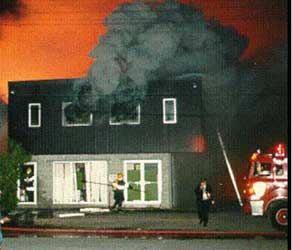
"Black Fire" - Photo
from the Ottawa FD
Black
Fire - This term has only recently been
officially recognized. This describes a situation
where HEAVY,
dense, black smoke is being emitted by a fire. This
smoke will be of high velocity, turbulent, high volume
and extremely dense. It will also be very hot. For
all practical purposes this is a dense, superheated,
cloud of fuel that is too rich to ignite. This smoke
may be doing as much damage as fire. It can also
be a sign of eminent flashover.
Booster -
This is a term that can be applied to not only a line
(see below) but to a particular type of vehicle. A
small piece of apparatus that carries a pump, water,
and a small, pre-connected line is often called by
the name "Booster". For more information
and photos, see: BOOSTERS
Booster
Line - A hose that is usually one inch in
diameter and rubber jacketed. But in some departments
this can be the name given to any pre-connected line
for the use of tank water. They are used on small
fires using the water carried in an apparatus' booster
tank and are usually stored on reels.
Box -
A means of determining which companies are closest
to an emergency location. Also slang for a "full
response".
See History Page
Box -
Slang term for MICU. Appears to be used by many departments. "I'm
on the 'box' today." Means, "Today is my
opportunity to be assigned to the MICU, thanks to the
fair and pleasant rotation schedule implemented by
our illustrious and wise station officer."
Box
alarm / Box Card- This term may mean slightly
different things in different departments. This comes
from the old practice of transmitting fire alarms
through a telegraph system. In general it means a "full
alarm" or a predetermined amount of resources
for a structure fire. To better understand this,
read the information about Joker boxes, Second Alarms,
Phantom Boxes etc. on the History
page.
Bugle (Speaking Trumpet) - In
the early days, of North American fire departments,
orders were given to the troops, by officers, through
the use of a large brass device that resembles
a megaphone. These were very ornate brass horns.
They were commonly called “bugles” or
speaking trumpets.

The
person with the bugle hanging from his neck or
shoulder was easily identified as the person in
charge. Officers became identified with these objects
so a small pin in the shape of a bugle became a
type of rank insignia for officers. The more “bugles
on his collar” the higher the rank. An expression
still used today.
For more information, go to Ranks and Organization.
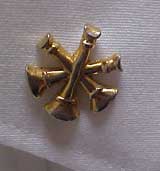
3 bugles collar brass.
Brush
Truck / Grass Wagon etc. - There are vehicles
for fighting wildland or grass fires. Some of these
are four wheel drive. In fact, there are some vehicles
constructed on Hum-V's. (But this is too expensive
for most fire departments.) Most often this is a
tank and a pump mounted on a four wheel drive pick-up.
The "A-Wagon" is often the grass fire apparatus
but it is very common to see them referred to as
these other names. It may also be called a "Patrol
Truck".
For more info and photos see: Brush
Trucks
Bunker
Gear - This is the
slang term for the protective clothing a firefighter
wears. It generally consists of: boots, trousers,
coat, gloves, hood, and helmet. It is technically
referred to as “Personal Protective Equipment” or “PPE” and
includes the SCBA. It is also known as "Turnout".
See "Turnout"
Jump
to: A-B-C-D-F-G-H-I-J-K-L-M-N-O-P-Q-R-S-T-U-V-W-X-Y-Z
≈C≈
Church
Raise - You
probably would not believe this if you saw it. Imagine
a 50 foot ladder sticking straight up in the air,
with a firefighter sitting on top of it. This is
basically a church raise. The ladder is balanced,
in the position, by only four ropes attached to the
top. Each rope is held by a firefighter who is keeping
the ladder balanced. Firefighters often use this
in training. It helps develop teamwork and trust.
It is rarely used for emergencies.
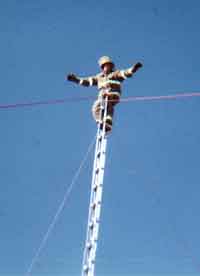
Photo - Michael Smith
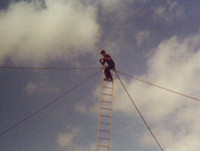
One of the authors of this site atop a 50'
church raise during rookie school in 1980.
(Taking a photo from the top.)
Clear -
This is the same as "In Service" or "Available"
for some departments.
Code
One - Traveling to a location with no lights
or sirens.
Code
Three - Traveling to an emergency location
WITH lights and siren. It should be noted that in
most states there is no such thing as “Code
Two”. However you may see apparatus traveling
through residential areas at night without the siren
on. This is just a courtesy to the people in the
area.
Code
Four - This is a signal that some police
departments use to convey that everything is under
control. Fire departments almost never use this term.
Note:
These codes are not to be confused with the complicated
codes used by some police departments. Some police
and even some fire departments do use a system of number
codes in an effort to talk privately or quickly on
the radio. The widespread knowledge of what these codes
mean and the use of cell phones have caused many cities
to abandon the practice in favor of plain language.
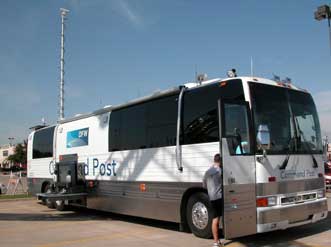
DFW Airport Command
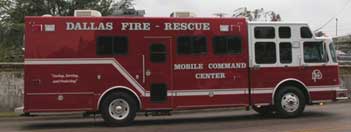
Dallas
(Texas) Mobile Command Center
Command -
Command exists for every incident. However, we do not
establish a formal incident command unless the incident
warrants it. If there are more than three companies
at a scene, command is usually established so that
everyone knows who is in charge. The first officer
on the scene usually has the option of taking command
or assigning it to someone else. Beyond that only chief
officers have the authorization to transfer command.
Note: These rules or guidelines can vary slightly between
departments but national standards are being established for Command.
This is becoming very important as the need for multiple agencies at
events grows.
Note: The large command vehicles are usually used only
on the very largest of events. (More than Three Alarms.) For most single
family home or apartments fires, command will be from a battalion chief's
vehicle.
Command
Technician - Firefighters trained in communications
and organizational skills. This is a person who must
be able to take in information and organize it, as
well as, present it to command in a way that makes
sense. Much
more information and photo.
CO
Detector - Fire departments have battery
operated devices that can measure gasses in the air.
These are often used to determine the presence of
Carbon Monoxide in structures after fires have been
determined “Under Control”. They can
also detect the presence of CO in homes and some
other gasses.
Jump
to: A-B-C-D-F-G-H-I-J-K-L-M-N-O-P-Q-R-S-T-U-V-W-X-Y-Z
≈D≈
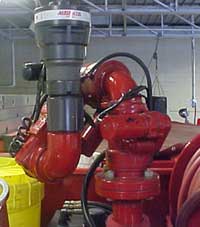
Engine
Bed Mounted Deck Gun
Deck
Gun - A large water nozzle attached to a
engine. Deck guns deliver larger amounts of water
than hand-held hose. (See also Master Stream or Multiversals).
This is also sometimes called a "deluge nozzle".
Defensive
Operations - This is what usually appears
on the news. This is a fire ground strategy based
on firefighter safety and the protection of exposures.
The goal is to simply confine the fire to the building/area
of origin. No aggressive interior firefighting operations
take place in the defensive mode. All fire streams
are operated onto the fire from the outside. This
strategy is employed when a fire has advanced to
the point where attack operations are too dangerous,
and/or the fire is beyond the capabilities of on
scene resources.
District
(or District Chief) - This is subdivision
within a fire department. This is usually comprised
of several battalions. Some fire departments use
the term "district" to describe a group
of resources made up of companies. This is more commonly
referred to as a battalion in the US. In Canada the
word district is usually used in place of the word
battalion.
Division – This can be a branch of the fire department such as the “Training Division” or the “Inspection Division.” It can also be a designated part of the Incident Command System (ICS). Division is used to designate a geographic location of operations. An example might be “Third floor division” or “Delta Division” (Which might indicate a side of a structure.) For Incident Command Definitions see HERE.
Drafting -
Pulling water from a source other than a hydrant or
another fire apparatus. Cisterns, lakes, ponds and
swimming pools are often used in drafting operations.
Many departments in rural areas and without fire hydrants
use drafting.
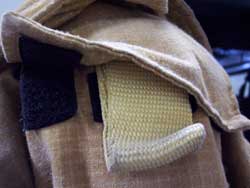
Drag Rescue Device (DRD)
DRD
- Drag Rescue Device - This is a strap,
or webbing, that is integrated with the firefighter's
turnout coat which allows for easier dragging. A,
relatively, small strap protrudes, from under a flap,
near the collar on the back of the fire coat. A rescuer
can grab this strap and have a means to drag a fellow
firefighter to safety. This is required on all new
coats in NFPA 1971, 2007 edition.
Jump
to: A-B-C-D-F-G-H-I-J-K-L-M-N-O-P-Q-R-S-T-U-V-W-X-Y-Z
≈E≈
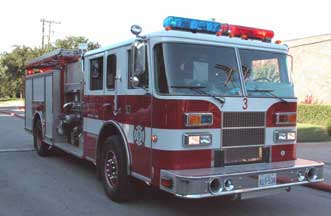
Irving
Texas - Engine 3
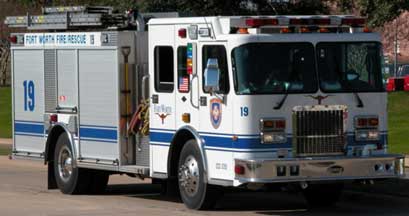
Ft. Worth Texas - Engine
19
Engine -
This is an apparatus designed for fire attack. It is
the most common vehicle in fire departments. This apparatus
carries, hose and usually about 500+ gallons of water.
It also has a fire pump. Modern fire pumps can pump
over 1500 GPM (Gallons Per Minute). These vehicles
can also have the ability to supply foam and usually
carries 3-4 personnel. Some departments, especially
in Canada, refer to these apparatus as "Pumpers".
Some departments, even in the U.S. may refer to their
engines as "Pump 2" etc. at times. They can
be just about any color. You can see apparatus colored:
Red, Blue, Black, Lime Yellow, Yellow, Green or White,
just to name the more common colors.
Engineer -
In most departments, the engineer is the person that
drives the Fire Engine or Ladder Truck. They can be
known by several names. "Driver" "Fire
Equipment Operator" (FEO). "Chauffeur" and
others. The engineer is also responsible for all of
the equipment that is on the apparatus and making sure
that it is clean and in good working condition. They
also run the pumps, ladders, etc. when they are at
a fire. If they are the driver of a truck, they are
responsible for running the aerial device (ladder etc.)
and other tools such as generators or extrication tools.
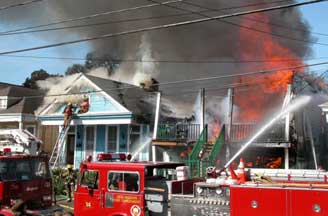
New
Orleans FD- Trying to save exposures 1-28-04
Exposure -
These are all the endangered structures or other property
that can be subsequently damaged by fire, traveling
from another fire. This can include anything from autos
to other buildings to stacked products to crops. The
protection of exposures is a prime concern with any
fire. Something that many people may not realize is
that large fires can radiate intense heat. This can
cause objects 100 feet away or more to combust. This
is why you may see firefighters applying water to structures
or objects across the street from heavy fires. There
does not have to be direct flame contact for an object
to apparently burst into flames. Fires from petroleum
products such as natural gas, propane, or gasoline
can be especially intense sources of radiated heat.
Vehicles are common victims of radiated heat. Paint
can be damaged or plastic parts melted great distances
from the actual fire.
Extrication -
The systematic and safe freeing or removal of persons
who are trapped or pinned. This can be accomplished
by highly technical means or may be a easy as opening
a locked door.
Jump
to: A-B-C-D-F-G-H-I-J-K-L-M-N-O-P-Q-R-S-T-U-V-W-X-Y-Z
≈F≈
FAST - Firefighter Assist
and Search Team.
See: "RIC".
Fire
District - This is different from a district
within a city or a District Chief. See "District
Chief". A fire district is an established tax
district. This may include several cities or towns.
It may also be a rural area. You can almost think
of this as a co-op. Many volunteer fire departments
are set up as districts that serve several communities.
But this is not always the case. There are some very
famous fire protection districts. Probably the most
famous is LA County. The City of Los Angeles has
it's own fire department but the rest of the county
is under one huge fire department. Today, 57 cities
contract with the Los Angeles County Fire Department
which staffs a total of 163 engine companies, 31
truck companies, 79 paramedic units, and numerous
other pieces of specialized apparatus. http://www.lacofd.org/ Many
consider this a very efficient way of providing fire
and rescue service. An example of NOT having a large
fire district might be Dallas County in Texas. There
are over 20 fire departments just in Dallas County.
Every city has a different way of doing some things.
This situation exists all over the country. Sometimes
cities, in order to adequately protect it's citizens,
are forced to build fire stations within sight of
another city's stations. A combined fire district
would prevent this. Resources could be shared or
spread more evenly. Unfortunately, cities are often
reluctant to let go of their fire departments once
they are established.
Flashover -
Similar to a backdraft with
the exception that the room is not closed or pressurized
to the point of explosion. All of the contents of the
room have given off flammable gases that have been
heated to their ignition point and a fire suddenly
envelopes the room. From the outside you will often
see the exiting smoke appear to instantly ignite.
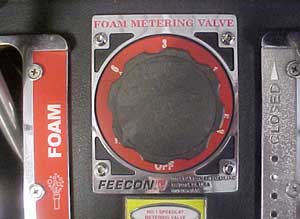
Foam
Metering Valve. Concentrations from .3% to 6%.
Foam -
This is a mixture of water and a product that causes
foam OR reduces the surface tension of the water. In
the movies you think of airports "foaming the
runways." Today, foam is use more often for structure
fires and protecting exposures. The mixture of foam
concentrate can be from as much 6% to as little as
.3%. The lower concentrations are to cause the water
to be able to penetrate burning substances by reducing
the surface tension. This is especially valuable in
situations where there is debris. It is difficult to
extinguish bales of hay or tires without foam. A mixture
of 3% might be used for a liquid hydrocarbon fire while
6% is used for burning alcohol. In the past it was
only specialized apparatus that had the ability to
pump foam at will. It is now common for fire engines
to be able to provide foam at the flip of a switch
in many communities. There is more than one type of
foam.
Forcible
Entry - This is a term often heard in news
interviews. It is the act of gaining access to a
structure or vehicle through means other than an
open window or door. Frequently, firefighters must
force open doors that are locked or blocked in order
to enter a structure to search for victims & extinguish
a fire. A wide variety of hand, power & hydraulic
tools can be used for forcible entry.
Jump
to: A-B-C-D-F-G-H-I-J-K-L-M-N-O-P-Q-R-S-T-U-V-W-X-Y-Z
≈G≈
GPM -
Gallons Per Minute. Everything we do, with regard to
extinguishing fires with water, is about GPM. We talk
of the amount of GPMs we will need to extinguish a
theoretical fire or while formulating strategy on a
working fire. A large apartment or warehouse fire may
require thousands of gallons a minute to stop the spread
and extinguish. A simple formula we might use is: length
X width = (area) X .33. Using this, a 6000 sq ft structure
would need a minimum of approximately 2000 GPM, per
floor, to extinguish. This is more than the average
fire hydrant or fire engine can provide.
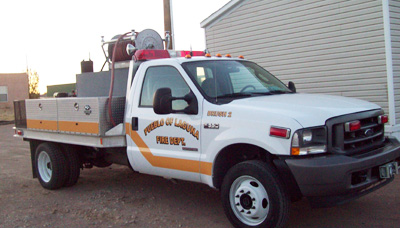
Pueblo of Laguna, NM, Fire Department
Grass Wagon - (also Grass Truck, A-wagon, Booster, Brush Truck, Patrol Truck and many other names.) This is a small vehicle, usually built on a pick-up truck frame. It carries a small amount of water and the main purpose is to fight grass fires. It will often have the ability to pump and roll and will sometimes have a seat of some form, mounted on the bed or rear, for the hose operator to use as they roll down a fire line.
Jump
to: A-B-C-D-F-G-H-I-J-K-L-M-N-O-P-Q-R-S-T-U-V-W-X-Y-Z
≈H≈
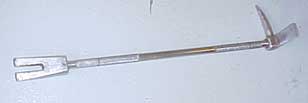
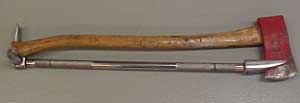
Halligan
Tool and "Irons"
Halligan -
An all-purpose steel prying bar used as a forcible
entry tool. It looks like a adze with a point on the
side. The story is that it was invented by a New York
City firefighter named Huey Halligan. In some circles
it is known as a "Pro Tool". Often this tool
is married together with an ax. Together with possibly
some other forcible entry tools, this is often referred
to as "Irons".
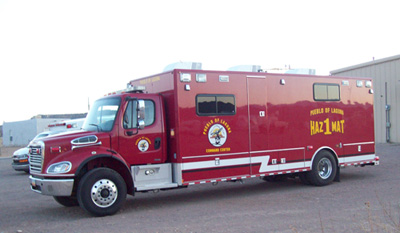
Pueblo of Laguna, NM, Haz Mat 1
Haz Mat - (also Hazmat, HazMat) This is short of "Hazardous Materials Response Unit." With today's complex and high technology world, many departments have invested resources and money to responding to such emergencies. Most of us would be surprised, if not alarmed to learn the many types and dangers associated with chemicals and products in our communities. Typically one department in a region will have a Haz Mat unit and through mutual aid agreements other departments will support and share that unit.
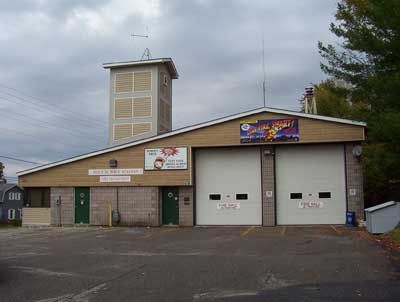
Nipissing, Ontario FD. Notice hose tower.
Hose Tower/Hose Rack - In northern climates the fire departments need a warm/indoor area to dry hose. In southern cities they usually just use outside racks made from metal. In the hose towers, the hose is hoisted up several stories and left to dry. On the hose rack it is just laid flat or on a slight incline. NOTE: In the past, hose was covered with a cotton jacket and had to be cared for to prolong its life for decades. The cotton would rot if allowed to remain wet for very long or it would mildew if rolled and stored wet. Today’s hose is designed to be rinsed off at the fire, and placed back on the apparatus wet. The jacket is made of mildew resistant synthetics and hose can only be in service for a short period of time before it is required to be replaced. For example, 1 ¾ inch hose has a service life of only 5 years. After this time, the hose must be disposed of, even if used very little, or none at all. For this reason, many cities are no longer constructing hose racks with new fire stations.
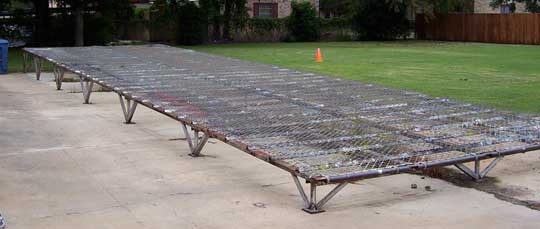
Hose rack for cleaning and drying hose.
Hurst
Tool - This is the common manufacturer of
something the public refers to as “The
Jaws Of Life”. There are several manufacturers
of similar devices but many departments use the Hurst
brand and will refer to theirs as “The Hurst
Tool”, "The Jaws", or simply as part
of their “Extrication Tools” etc.
Jump
to: A-B-C-D-F-G-H-I-J-K-L-M-N-O-P-Q-R-S-T-U-V-W-X-Y-Z
≈I≈
Incident
Command - See Command.
Irons -
See "Halligan Tool"
ISO -
Insurance Service Office - This is a, for profit, organization
that provides statistical information on risk. see: http://www.iso.com/ For
many years the "ISO Rating" had a large impact
on most fire departments. The ISO (PPC) rating is from
10 - 1. With "1" being the best. At one time,
almost, all insurance companies calculated rates based
upon the ISO rating. For
many years homeowner insurance premiums were calculated
using something called the "ISO / PPC" System.
(Insurance
Service Office / Public Protection Classification)
A few states had their own rating system, such as the "Key-Rate" system)
but even this accomplished the same thing. Around 1990
the last remaining state adopted the ISO/PPC system.
But just as the last remaining state was getting used
to the ISO system and all its various inspection idiosyncrasies,
State Farm and some other insurance companies tossed
it out in many states. So now ISO ratings have
very little, if any, effect on insurance premium rates
in several states. For more information on
the new system see this page: ISO
If
anyone has more current information on ISO, please
send it to me.
2001
Article in Firehouse Magazine about State Farm's change,
with more details on the PPC and ISO rating system.
It also talks about the "Subzone Rating Factor" system.
http://server.firehouse.com/news/2001/3/20_iso.html
In
2001 Arkansas tried to fight State Farm's change to
the "loss per zip code" system.
http://www.percymalone.com/news010824.html
http://www.percymalone.com/news011214.html
Jump
to: A-B-C-D-F-G-H-I-J-K-L-M-N-O-P-Q-R-S-T-U-V-W-X-Y-Z
≈J≈
Jaws
Of Life - See "Hurst Tool" above.
Joker
System, Joker Box etc. - See
Fire Service History Page.
Jump
to: A-B-C-D-F-G-H-I-J-K-L-M-N-O-P-Q-R-S-T-U-V-W-X-Y-Z
≈K≈
K-Tool - A
very effective tool
for the removal of door cylinders in mostly commercial
structures. The firefighter simply slides the "K" shaped
tool over the lock and then pry down with the halligan.
The cylinder pops right off, giving easy access
to the latch. This
tool is often included with "irons".
Jump
to: A-B-C-D-F-G-H-I-J-K-L-M-N-O-P-Q-R-S-T-U-V-W-X-Y-Z
≈L≈
Ladder (as in "Ladder 49") - This is another name for a truck company. See "Aerial
Truck" above.
Ladder
Pipe- This is the process of pumping water
to a nozzle mounted on an aerial ladder. This can
be a ladder with plumbing built in or it can be the
process of laying hose on the ladder and attaching
it to a nozzle and the rungs.
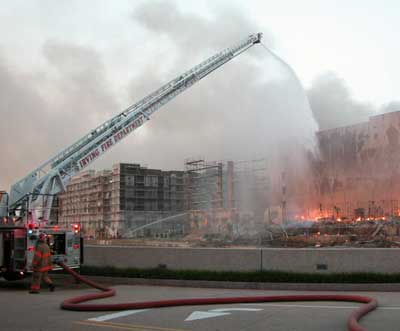
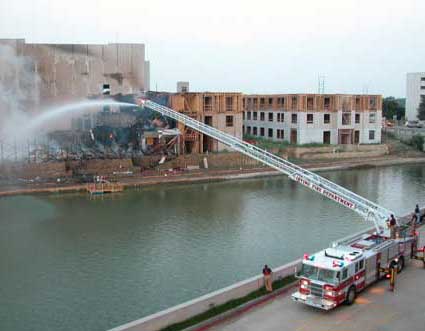
Irving Texas, 8-2-04
“LDH” Large
Diameter Hose - This is usually hose that is 5 inches
in diameter. Using this hose, large volumes of water
may be transported, under relatively low pressure.
Many departments have converted to LDH from 3 inch.
Some may carry both on their apparatus to give them
flexibility and options. You may hear this referred
to, on the radio, as “LDH” or “5
inch”. You can’t drive over this stuff
or move it. It is too big and heavy. If a fire department
has time, you may be able to get them to place hose
bridges so you can get over this hose. Do not
let your vehicle get caught on the wrong side of it.
You may be there for the duration if you do.
Jump
to: A-B-C-D-F-G-H-I-J-K-L-M-N-O-P-Q-R-S-T-U-V-W-X-Y-Z
≈M≈
Maltese
Cross -
One can easily find web sites that will tell you
that the current emblem of the fire service, in the
U.S. and some other countries, is based upon the
cross worn on the tunics of the Knights Hospitallers
of
Jerusalem,
AKA the "Knights
of Malta". But there is evidence that the current
emblem bears little resemblance to this cross. However
that does not mean that it wasn't originally based
upon the "Maltese Cross". Perhaps it has
just evolved and adopted other icons as well. The
cross of St. Florian is one design that may have
influenced the current shape. Much more information,
on the subject, can be found here. The
Maltese Cross and the Fire Service.
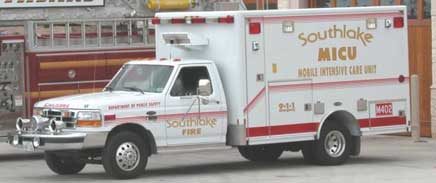
MICU -
(Mobile Intensive Care Unit)
This is what many people mistakenly refer to as an “ambulance”.
Many fire departments will still write the word “ambulance” on
these vehicles because people expect it. A MICU is
capable of Advanced Life Support (ALS). In the past,
the job of the ambulance was to transport the patient
to medical care as soon as possible. The term "ambulance" comes
from the word "ambulate" which means "to
move about". Today the goal is to bring advanced
medical care to the patient as quickly as possible.
With the exception of some procedures, such as blood
replacement, surgery and some lab tests, the paramedics
on the MICU can perform just about any procedure you
would get at a hospital emergency department in the
first thirty minutes of care. There are some variations
on the name of this vehicle. In Canada they may be
labeled, "Advance Life Support Ambulance, Ministry
of Health". I have also seen "ALS Ambulance" on
the side of vehicles.
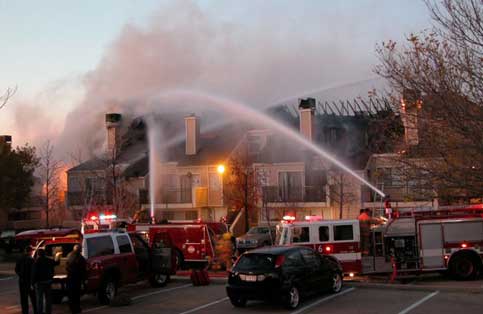
Several
Master-streams (deck guns and aerials) in action.
Notice "Command" in the lower left. Irving, Texas
Monitor,
Multi-versal, Master-stream - A large ground
or apparatus mounted nozzle through which large amounts
of water can be flowed. This device can often be
remotely operated or it can be set up and allowed
to run unattended.
Mutual
Aid - This is an agreement between jurisdictions
for the mutual assistance in the event of major events.
Even the largest departments may need help from time
to time. There is usually a pre-agreed upon procedure
for implementing mutual aid. There can be pre-established
automatic mutual aid. A city may agree to always
take the runs for another in some remote location.
Smaller departments depend upon mutual aid agreements.
MVA
/ MVC - Motor Vehicle Accident, Major Vehicle
Accident, Motor Vehicle Collision. While most departments
still use the term "MVA" some have gone
to "MVC". It is felt that the word "accident" has
some meanings that reflect blame or the lack thereof.
Perhaps they feel that "collision" is a
more accurate description of what has happened.
Jump
to: A-B-C-D-F-G-H-I-J-K-L-M-N-O-P-Q-R-S-T-U-V-W-X-Y-Z
≈N≈
NIMS -
The National Incident Management System.
A federally mandated program for the standardizing
of command terminology and procedures. This standardizes
communications between fire departments and other agencies.
It is based upon simple terms that will be used nationwide.
Currently, U.S. federally required training programs,
from DHS, NFA and FEMA, are in the process of standardizing
many terms and procedures under NIMS.
National
Fire Academy (NFA) - In 1974 Congress passed
The Federal Fire Prevention and Control Act (PL 93-498).
Among other things it established the United States
Fire Administration (USFA) and its National Fire
Academy (NFA). Both career and volunteer firefighters
attend this school, in Emmitsburg MD for advanced
education in fire protection. It also offers courses
for citizens in fire safety.
See: http://www.usfa.dhs.gov/about/
Jump
to: A-B-C-D-F-G-H-I-J-K-L-M-N-O-P-Q-R-S-T-U-V-W-X-Y-Z
≈O≈
Out -
This is a radio term meaning, "Out at the emergency
location." When you are usually "on scene" and you are
out of service. It can also indicate that a fire is completely extinguished.
Overhaul -
The systematic search for hidden fires or for fire extension. It is generally a damaging process. If the fire impinges upon a wall, that wall will probably be opened to insure that the heat and fire hadn't communicated through to the inside.
Jump
to: A-B-C-D-F-G-H-I-J-K-L-M-N-O-P-Q-R-S-T-U-V-W-X-Y-Z
≈P≈
Pass
Device - This is one name given to the device
all firefighters wear for locating firefighters in
trouble. This device senses if a firefighter has
remained motionless for a short period of time. It
may also sense if the firefighter has been exposed
to a rapid rise in temperature as may occur with
a collapse. A piercing alarm is sounded under any
of the conditions for which it is designed to detect.
They are usually attached to the SCBA. You will often
hear this device sounding because a firefighter has
laid down his SCBA. These devices often do not have
a simple way to turn them off and they will become
active when the firefighter simply removes the SCBA
from the apparatus or turns on his air supply. This
solved the problem with earlier versions where the
firefighter had to remember to turn it on.
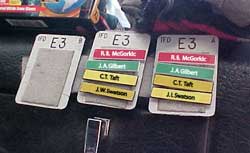
Passports
Passport
- This is just one type, of many, personnel
accountability systems in use today. In the past,
command would just try to keep track on the personnel
in a hazardous environment or situation by just writing
down vehicle numbers. But that was not very accurate
at times. Today each company has some type of object
with each person's name on it. The names can be written
on or they can have a name tag that is affixed by
a clip or velcro. The officer gives this object to
command or the sector officer prior to entering a
hazard zone. This way someone can always tell exactly
who is where. If it becomes necessary to divide up
companies, this can be done by moving names around
and attaching them to other boards. In the example
above the four people on this engine could be divided
into two crews. This is the purpose of the third,
empty, passport.
"PAR" or "PAC" etc.- Personnel Accountability Report
(Check) etc. At various points during
a operation command will call for a "PAR" (or
some similar acronym). This might also be referred
to as a "Roll Call". All company officers
will report that they have their crew in sight or physical
contact. They will respond with, "Engine 3 has
PAR." or "Truck 9, PAR." An accountability
report happens at timed intervals or when they situation
has changed. Examples would be: Partial structure collapse,
Fire Under Control, Change in tactics, Report of lost
or injured firefighter.
Patrol
Truck - It seems that small vehicles, designed
for fighting grass or brush fires can be called anything.
(See, A-wagon, Brush Truck, Grass Wagon, etc.) In
some communities, a small water tank (around 200
gals) mounted on a pick-up, with a one inch line
and a 200 GPM auxiliary pump, is called a patrol
truck. This is used to patrol large grass fires.
The truck will also usually carry tools like shovels
and axes, etc. Patrol trucks appear to be most common
in California, but can be found in other regions
as well.
Pike
Pole - A pike pole could be any number of
designs for a piece of equipment used for overhaul.
Most often it is use for the opening of ceilings.
Of all the tools of the fire service, the pike pole
is probably among the most often used. It is often
the practice to have one carried in by a firefighter
at all structure fires. The most common design is
a hook with a point. See illustration. But there
are many styles and designs. The pike pole is the "mouse
trap" of the fire service. It seems that almost
everyone believes that they can create a better one.
The Dallas Fire Department is famous for one that
looks like a harpoon that has a hammer type of handle.
If you have ever seen a dent puller with a slide
hammer type of handle, you can get the picture. A
few designs are pictured.

Platoon - This is the term used by some departments to describe the shifts. Rather than say that there are three shifts, (A, B, & C) they will say that that there are three platoons.
Plug -
Slang term for a fire hydrant. This survives from the
days when water mains actually had holes in the tops
that were plugged. Many firefighters would like to
keep this word while many others think it should be
replaced with the accurate term, "hydrant".
For more info see :Fire
Plug in the Q & A Page
Pumper -
Another term for an "Engine". More common
in some parts of the country then others, but you can find
this term in some use in almost any region.
Primary
Search - Very early in any fire or hazardous
environment search or rescue Command will call for
a "Primary Search". This is a quick search
of all compartments in a structure for victims. The
crews involved in the search should report, "Primary
Search, All Clear."
Pompier
Ladder - This is a ladder reportedly named
for the firefighters of Paris, who are known as Pompiers.
This ladder has a large hook on one end. A firefighter would stick this in
the window of the floor above him, climb out the window and up the ladder,
where he would repeat the process. The usual pronunciation is just like it
is spelled, "pom-pier" even though the French for firefighter is
pronounced, "Pom-pe-ay".
For more information and photos, go to: "Pompier Ladders"
Public
Information Officer (PIO) or Media Information Officer -
In all cases, media information will be handled by
command. This is a defined and designated responsibility
of the incident commander. This position will be
filled or staffed by command. The “Incident
Commander” will be the person to give the media
information and answer questions or they will detail
someone to do this. At times the incident commander
will not have time to talk with the media. But you
can rest assured, that as soon as possible, someone
will be speaking to the press.
Jump
to: A-B-C-D-F-G-H-I-J-K-L-M-N-O-P-Q-R-S-T-U-V-W-X-Y-Z
≈Q≈
Quad -
Apparatus that has four capabilities. While not as
common as a "Quint" some departments do use
such vehicles.
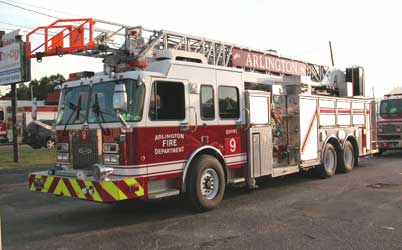
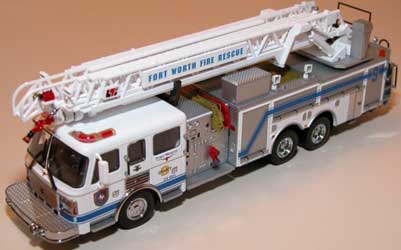
Arlington and Ft. Worth, Texas - Quints - Notice the pump panels and hose hand
lines on each vehicle.
Quint -
A piece of firefighting apparatus that can perform
five of the major functions of fire apparatus. These
include: Carry hose. Carry water. Pump water. Aerial
ladder/water tower operations. Should also carry large
amounts of ladders of to be considered a truck.
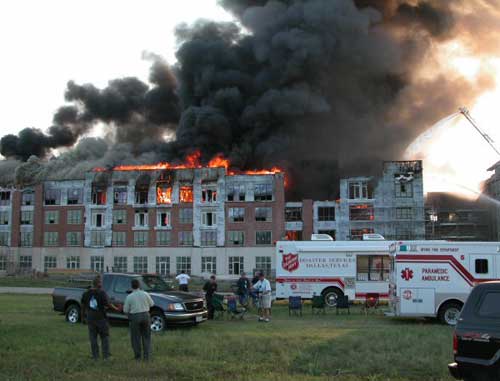
R&R,
8-2-2004 Irving Texas, 100 degree day, 5 alarm fire. (Click
photo to see more.)
Jump
to: A-B-C-D-F-G-H-I-J-K-L-M-N-O-P-Q-R-S-T-U-V-W-X-Y-Z
≈R≈
R&R,
Rest and Recovery (or Recuperation) - This
a location or procedure allowing emergency workers
to take breaks and recover. It might be as simple
as getting a drink and a fresh air cylinder or it
may involve food or even medical checks. It depends
upon the extent of the operation. The time of year,
summer v. winter, can also play a part in what is
offered in R&R. It might be a place to cool off
or warm up. Some departments have vehicles designed
just for R&R. They might have cook tops and bathrooms.
These are somewhat rare. Most departments will set
up some kind of area under a tree or awning etc.
Radiated
Heat, (Infrared Radiation) - Fire can produce
intense radiated heat. This "radiated" energy
travels through clear mediums (i.e. air & glass)
without a problem. But when it strikes an opaque
surface this energy excites the molecules and warms
the surface. This can cause the object to combust
even though it may be many feet from actual flame
contact. See: "Exposure"
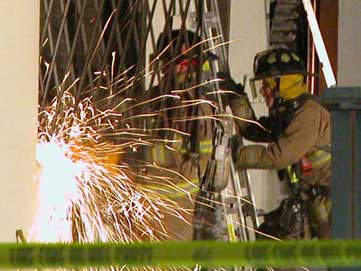
"RIC" or "RIT" - "Rapid
Intervention Crew" or "Rapid Intervention
Team" This will be a crew who is established strictly
for the purpose of rescuing emergency personnel. Some
form of RIC is required by NFPA 1500 and CFR 291910.
They will assemble a collection of rescue tools and
spare breathing apparatus. They cannot be used for
firefighting unless a new crew is detailed to take
their place. These people can be rotated as relief
to the fire if another crew is detailed as the RIC.
Note: in some areas this may be a "Rapid Intervention
Group" (RIG) but this can be confused with the
fact that some regions refer to apparatus as "Rigs".
A call on the radio for a "rig to the north side" might
confuse a mutual aid company. See also: "FAST".
Note:
While all of these versions of the name for a firefighter
rescue crew either have been used or continue to be
used in several areas, the National Incident Management
System (NIMS) has determined that
Rapid Intervention Crew "RIC" will be the
national term. Currently, U.S. federally required training
programs, from DHS and FEMA, are in the process of
standardizing many terms and procedures under NIMS.
"Rig" -
An expression used, in some parts of the country, to
describe a piece of apparatus. This is the entire vehicle.
You may hear about connecting "the supply line
to the rig." This describes the engine or pumper
in this case. Firefighters develop a personal attachment
to their rigs. While some areas used this term often,
others will never use it.
Jump
to: A-B-C-D-F-G-H-I-J-K-L-M-N-O-P-Q-R-S-T-U-V-W-X-Y-Z
≈S≈
Salvage -
The procedure whereby property is protected or saved.
This can commence at the same time as firefighting
or it can occur later. Salvage operations often include
the covering of furnishings with tarps known as “Salvage
Covers” or it can be as simple as placing a pan
under a water drip to protect the apartment below.
SCBA (Self Contained Breathing Apparatus) -
This is the breathing apparatus firefighters wear.
A common mistake is to think that there is only oxygen
in the cylinder. There is not. The cylinder the firefighter
wears is filled with the same air everyone breathes.
Imagine the amount of air in a box measuring four feet
in every direction. That is about how much air each
firefighter has. Each cylinder is rated for a specific
amount of time, usually 30 - 60 minutes, but that is
based upon little or no exertion. A 30 minute SCBA
may only last 10 minutes under some conditions. Some
departments may refer to their SCBA's by their brand
names such as "Scott's" or "Dräger's" or "MSA's".
Second
Alarm - (Third alarm etc.) In short, this
is the number of times that companies are requested
or dispatched to a fire. A full first alarm or "box" is
a predetermined number of companies. The "second
alarm" is the incident commander requesting
another predetermined group of resources. There are
several sections on the Fire
Service History Page that touch on this subject.
Secondary
Search - Once the fire is under control
a second search of the structure will be conducted.
The searching companies should report, "Secondary
Search, All Clear."
Sector
Officer, Sector, Sector Command - Often
various operations subdivisions must be established.
This can be fire area sectors or other divisions.
For high rise fires each floor of operations will
likely be a sector. In some incidents there may be
an EMS or triage sector. The officer in charge of
each sector will direct operations within his or
her sector without giving specifics to Incident Command.
If a fire structure is divided into sectors they
will often be set up by sides. They may be referred
to as "A" or "B" sector etc.
Some departments may set up "North" or "South" sectors
for some incidents.
Siamese -
A device which is used to combine two lines into one.
(Not to be confused with a "wye" which
splits one line into two.)
Size
up - This
is the procedure and the report of the situation.
The first arriving officer on the scene will "give
a size-up" over the radio. This will include
a description of the structure and the initial plan
of attack. It's been said that size-up starts even
before you leave the station. The time of day, the
weather conditions, the availability of water and
what you may already know about this structure are
examples of factors that go into size-up. Once you
arrive you don't just look at the fire. Are there
cars in the driveway? Are there toys in the yard?
Are the newspapers piled up? Many things go into
size-up.
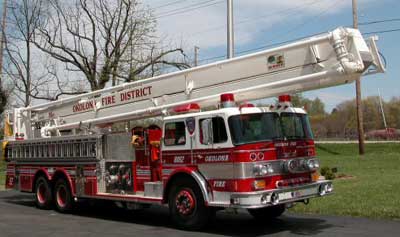
Snorkel,
Okalona, KY
Snorkel
- Sometimes people refer to any water tower,
aerial ladder or elevated platform as a "Snorkel".
This is inaccurate. A Snorkel is a brand name of
articulating boom with a platform. It will usually
have the ability to spray water from the platform
permanently plumbed into the system. There are several
types of aerial devices. Some are just large extension
ladders. Some are ladders with a platform on the
end. The articulating boom has the most versatile
reach, but rescue efforts are slowed because the platform
must be raised and lowered to bring people to the
ground. A ladder or a platform on a ladder has the
ability to allow a steady stream of people to exit
the upper floors of a building without the need to
go up and down itself. Just about any aerial device
can be configured to have an elevated nozzle. See: Water
Tower.
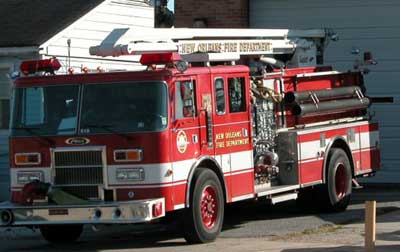
A "Squirt".
New Orleans, LA.
Squirt
- A smaller, articulating boom, usually
mounted on an engine. The main purpose is to have
an elevated fire stream. This does not make an "engine" a "quint" or "quad".
This gives the engine's deck gun more reach and versatility.
This is not a Snorkel, although the Snorkel company
did manufacture such devices in the 1960's and 70's.
Still
Alarm - Not every department uses this term
and some will have a slightly different definition,
but for the most part, this is basically an alarm
that isn't a structure fire or more specifically,
it does not get a box. I have heard several explanations
of where this term originated but none I would want
to print yet.
Jump
to: A-B-C-D-F-G-H-I-J-K-L-M-N-O-P-Q-R-S-T-U-V-W-X-Y-Z
≈T≈
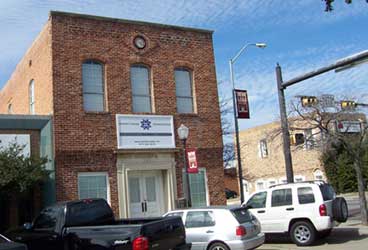
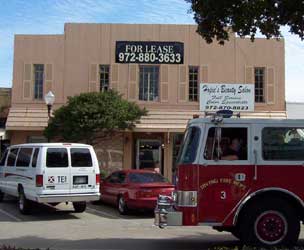
Some "Taxpayer" structures.
Taxpayer -
This is the fire service name for a small structure
that has a business on the lower floor and a residence
on the second floor. The residence may be presently
used as an office, but it is still considered a "taxpayer" style
of building. You will find these in older downtowns
or neighborhoods. In some areas this might be the name
given to any store with a residence connected but not
necessarily two story.
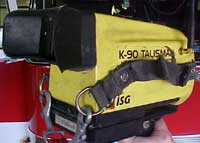
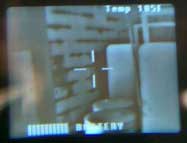
One
type of Thermal Imaging Camera
Thermal
Imaging Camera - This is a camera that can
be used to seek out hidden fires or see through smoke.
It uses thermal imaging technology to detect the
heat given off by objects. It can detect a difference
of 1/10th of a degree. Some cameras have the ability
to transmit the image back to command where it can
be viewed or even recorded. The camera can also tell
you the temperature of the object in the cross hairs.
Some versions are hemet mounted. This device is so
sensitive that it could help us find a victim who
is is completely under many layers of bed covers.
You may hear a fire crew ask for the camera by requesting “the
TIC” or some other acronym. In most
departments the cameras are not carried by every
piece of equipment. Battalion chiefs or trucks may
have them. For more information and photos on this
you may go to: http://www.ci.irving.tx.us/Fire/cameras.htm
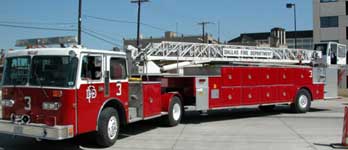
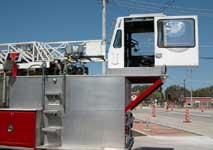
Dallas
Fire Dept. T-3
Tiller
or Tillerman - This is the name given to
the driver who sits at the very back of those long
ladder truck you used to see in the movies. This
person steers the rear wheels. Only a few departments
still have these kinds of vehicles.
Triage -
A method of determining priority of treatment. This
involves a quick treatment of those life threatening
conditions that can be corrected in seconds. The actual
requirements placed upon triage can vary depending
upon the situation. In the worst of situations, with
multiple patients, CPR is not performed. In situations
where there is adequate manpower, CPR may have been
considered in a similar patient. Often a officer who
is an EMS supervisor is placed in the position of “Triage
Officer”. But any EMS person may be given this
task.
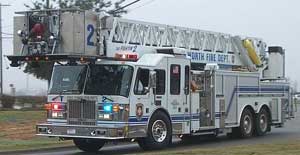
Truck -
This vehicle carries equipment and ladders. The equipment
may include: Lights. Generators. Salvage equipment.
Overhaul tools. Forcible entry tools. Rescue tools.
It may also transport personal to the scene. See "Aerial
Truck" above.
Turnout
Gear - Bunker Gear.
Jump
to: A-B-C-D-F-G-H-I-J-K-L-M-N-O-P-Q-R-S-T-U-V-W-X-Y-Z
≈U≈
≈V≈
Ventilation -
The process of removing heated gasses or smoke from
a building. This makes the building more tenable and
helps to prevent such things as flashover or backdraft.
This can be accomplished by several methods, from opening
a window to cutting a hole in the roof. It can also
be accomplished by forced ventilation, using high powered
fans for horizontal ventilation.
Vigili Del Fuoco - (AKA: Corpo Vigili Del Fuoco) The Fire Department in Italy.
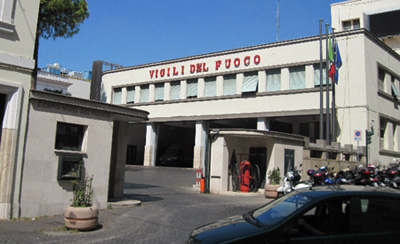
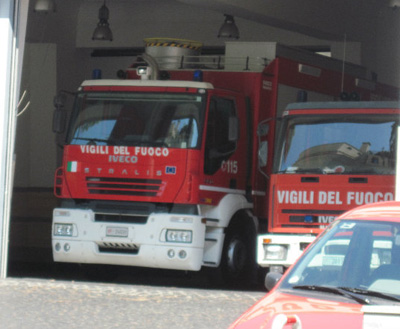
Jump
to: A-B-C-D-F-G-H-I-J-K-L-M-N-O-P-Q-R-S-T-U-V-W-X-Y-Z
≈W≈
Water
Thief - A gated wye with (usually) a 2 1/2
inch inlet, two 1 1/2 outlets and a 2 1/2 outlet.
This allows you "steal" water from a supply
that is going elsewhere.
Water
Tower - This is the name given to operations
where the aerial on the truck is used to provide
an elevated fire fighting nozzle. Just about any
apparatus mounted aerial device can be used for this.
Most ladders or articulating booms now have a water
pipe built into the system. But even one that does
not can quickly be adapted. In these cases a hose
of 2 1/2 to 3 inches is laid on the ladder and secured
to the top fly. A nozzle is clamped to the top rung
and you are in business. The nozzle angle or pattern
can be fixed or it might be changeable from the ground
by cables. see: Truck
"Wet
Water" - Water which has had a wetting
agent added. Doing so reduces surface tension and
allows the water to penetrate into the burning substance
more easily. This it helpful in several applications.
One of the best examples might be the overhaul of
bails of hay. It will also assist with some structure
fires. The agent can be as simple as dishwashing
soap or a foaming agent that is added at a VERY low
concentration.
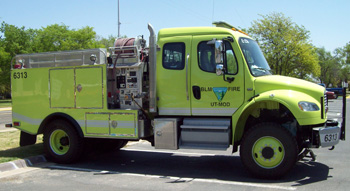
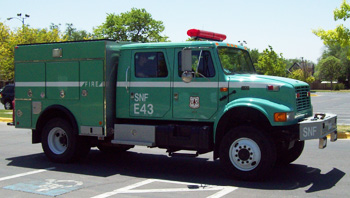
Wildland firefighting - The act of attempting to control brush, grass or forest fires. Some of these operations will last for days or weeks. These efforts will often include airdrops of water or fire retardant as well as special crews and special apparatus. Pictured above are a BLM crew vehicle and a National Forest Service engine stationed in Canyon Texas.
Wye (Y)
- A device for splitting one hose into two (usually
smaller) lines. (Not to be confused with a "Siamese" which
is used to combine two lines into one.)
Jump
to: A-B-C-D-F-G-H-I-J-K-L-M-N-O-P-Q-R-S-T-U-V-W-X-Y-Z
≈X≈
≈Y≈
≈Z≈
Please contact for permission to reproduce anything on these pages.
If
you have a fire service related page, please feel
free to place a link to this page on your site.
Most
Action Photos Copyright© Ben Saladino. Most photos
since November 2002 taken with Nikon Coolpix 5700.
See hundreds more at:http://www.bensware.com/firetrucks/photos.htm
fire
service history, jargon, slang, terms, terminology,
fire fighter lingo, fire fighter history, firefighter
terms, fire fighter training, firefighting terminology,
firefighting terms, fire fighting terminology, fire
terms defined, firefighter language, lingo, slang,
jargon, tools, devices, firefighter tactics paramedic
terminology, EMT.